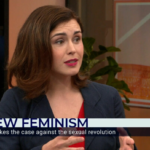A review of The Feminist Gospel. By Mary Kassian.
Crossway Books, 1992.
Several good critiques of religious feminism have appeared lately, including two from Ignatius Press: Ungodly Rage, by Donna Steichen, and What Will Happen to God: Feminism and the Reconstruction of Christian Belief, by William Oddie.
While these books focus on feminism in the Catholic Church, Mary Kassian’s book looks at the situation mainly in the Protestant context. (Kassian is a Baptist from Edmonton, Canada, and she writes from the perspective of an evangelical.)
The Feminist Gospel is an examination of how feminism has penetrated the churches in the last three decades. Moreover, it assesses the basic precepts of feminist theology and compares them with orthodox formulations of Christian thought. Kassian argues that the impact of feminism on the churches has largely been destructive.
In so arguing, she does not negate all of feminism. Some aspects of feminism have been helpful. But in the main, the churches must beware of the feminist gospel: “I believe that feminism has drawn attention to crucial problems that exist for women in society and in the Church. In this work I am not so much debating the validity of the questions that feminists have posed, but rather seeking to evaluate the validity of their answers. I hope to determine if the feminist answers will, in fact, solve the problems that exist.” As will become clear, Kassian feels that the answers given by feminists have not been helpful.
The early chapters of The Feminist Gospel trace the emergence of the women’s movement in the West, both in its secular and religious expressions. She argues that “religious feminist theology did not develop as a result of secular feminist philosophy, but rather emerged and developed concurrent to it”. Both were a result of the social upheaval of the early 1960s.
The bulk of the book deals with the various ways in which both secular and religious feminists have looked at and thought about the basics of Christianity: God, the Bible, theology, the church, what it means to be a Christian, and so on. Kassian makes it clear that no aspect of Christianity is left intact in the feminist revision. Indeed, some of the more radical feminists have basically rendered the Christian faith as we know it incomprehensible, so thorough has their revisionism been.
What the feminists did to orthodox theology is a case in point. Kassian carefully examines the way in which the feminists transformed Christian teaching. Feminist theology, argues Kassian, has undermined every basic Christian doctrine, resulting in a new theology which may be woman-centred but is certainly not Bible-centred.
Listen to the way in which the Biblical concept of sin is redefined by the feminists: Sin is a “situation in which there is no community, no room to live as a whole human being”; or again, sin is “the dehumanization of others by means of excluding their perspectives from the meaning of human reality and wholeness”.
Or see how the concept of salvation is metamorphosed: “Salvation has to do with new joy and wholeness, freedom and hope” says one feminist theologian, “. . . everyone who is working and longing for freedom is eagerly longing to catch a vision of what ‘it means to be free.’ For to be set free is to become real live children of God and to be part of a universe inhabited by these real live children! … Because we are all on this journey toward freedom together, we do not know exactly what children of God look like.”
The doctrine of the Trinity was also challenged by feminists. The traditional Trinitarian formula of Father/Son/Holy Spirit has been replaced by names such as Creator/ Redeemer/ Sustainer or Source/ Servant/Guide. The difficulty with this practice, writes Kassian, is that “it speaks to what God does rather than to whom He is. Father/Son/Holy Spirit refers to a threefold self-relatedness within the Godhead and not to a human or societal relationship. The Trinitarian names are ontological symbols based on divine revelation rather than personal metaphors having their origin in cultural experience”.
Similarly, attempts to insist on inclusive language to describe the Godhead have also proven to be chimeric. The feminists claim that using female as well as male pronouns to address God would desexualize Him. But in effect, the opposite has occurred: “When feminists switched from the masculine to the feminine in their description of God, they reduced God to sexuality. They presented an image of a deity who is bisexual or androgynous rather than one who transcends the polarity of the sexes”.
The feminization of God was attempted not only in terms of language, but in terms of essence as well. “God is going to change. We women are going to bring an end to God,” said one feminist. Feminists encouraged women to use their imagination in creating new visions of God and new forms of worship and ritual. Each woman should choose for herself how to symbolize and worship God. The result, as would be expected, was disastrous: “Feminists dethroned the Judeo-Christian God and proudly set themselves up in His place.”
Indeed, every heresy and cultic practice which Christianity has historically and traditionally opposed was incorporated into the feminist spirituality. Elements of witchcraft, spiritism, occultism, New Age-ism, pantheism, gnosticism, asceticism and neopaganism were all included as women broke free from the shackles of Scripture and tradition.
Goddess worship came to replace the more traditional norms as the core of the new feminist theology. One American religious studies professor put it this way: “The image of the Goddess inspires women to see ourselves as divine, our bodies as sacred, the changing phases of our lives as holy, our aggression as healthy, our anger as purifying, and our power to nurture and create, but also to limit and destroy when necessary, as the very force that sustains all life. Through the Goddess, we can discover our strength, enlighten our minds, own our bodies, and celebrate our emotions. We can move beyond narrow, constricting roles and become whole.”
While not all religious feminists felt comfortable with including goddess and neo-pagan worship alongside Christianity, many felt that one should at least keep an open mind. Says Kassian, “Just as secular feminists were forced to tolerate lesbianism, likewise, religious feminists found that they could not justifiably condemn those who advocated pagan worship practices”. Indeed, as one religious, feminist said: “… even for those who want to stay within the Jewish and Christian legacy, the work of neopagan or nonbiblical feminist spirituality is important. Goddess religions have powerful symbols that stretch our understanding of religious practice and human experience”.
Such syncretism and accommodationism is an inevitable result of an anthropological as opposed to a theological approach to religion. Indeed, it is exactly the kind of apostasy about which Jesus warned his disciples. But can there be a conservative, Biblical feminist theology? Kassian devotes a chapter to this question, focusing on those who want to remain true to Scripture while adopting feminist concerns. Such people call themselves “Biblical feminists,” for they believe in the Bible, but also believe in feminism. After examining a number of writers who affirm such a view, Kassian concludes that “Biblical feminism” is an oxymoron [contradiction in terms]: “Biblical feminists have tried to join feminism and conservative Biblical Christianity in a harmonious stream. But even though the two were forced, as it were, to flow out of the same trap, they remain inapposite. Feminism and Christianity are like thick oil and water: their very natures dictate that they cannot be mixed.”
Feminism is but the latest in a long line of forces which have appeared over the centuries seeking to undermine the church. Like the others, it too will pass, while the church remains. But for the present it is a very real threat to the Christian church. This book will be of great help in combating this threat and alerting believers to continue in vigilance.
[1311 words]



















